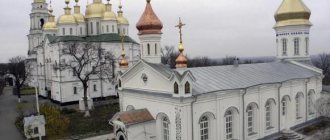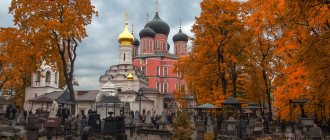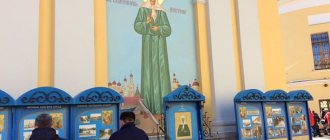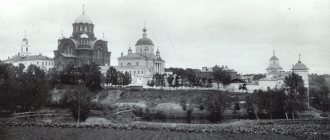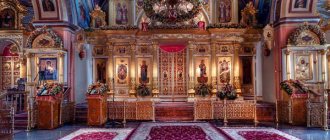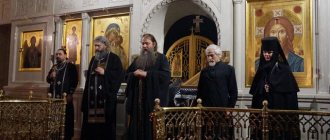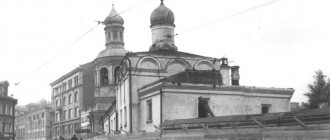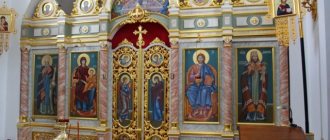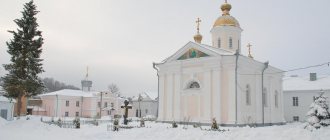This place of God is the most visited church complex in the capital. Christians come here to personally touch the relics of the Venerable Elder Matrona, who encourages every mourner to turn to her and ask for miraculous help.
The saint is able to heal various diseases, restore financial well-being, strengthen faith in the Lord and give the gift of a long-awaited child. The remains of the holy old woman have been kept in the Intercession Monastery since 1998.
Intercession Convent, Moscow
How to get to the monastery by car or public transport
| Metro starting point | Route | Features of the route |
| Marxist | Exit to Taganskaya Street, follow the sign, continue walking along the route of transport to the intersection with Bolshaya Andronevskaya Street. | On the right side is the entrance to the monastery with the icon of Elder Matronushka. Travel time is about 10 minutes. |
| Proletarskaya | Go out onto the street and continue along the tram tracks of Abelmanosvkaya Street | You can walk to the monastery in 10-15 minutes at a leisurely pace. |
| Taganskaya | Exit to the square, cross the highway and continue driving to the Zvezdochka store. Opposite is the arched entrance to the monastery | The store is visible immediately after exiting the metro |
| Ilyich Square | When exiting, follow the sign for Abelmanovskaya Street | The journey will take approximately 15 minutes on foot |
| Marxist | Exit to Taganskaya street | Any ground transport goes to the monastery |
| Proletarskaya | Take tram 35, 38 to the Abelmanovskaya Zastava stop | The monastery is located on the opposite side |
| Peasant Outpost | The station is located near Proletarskaya, the route is similar to the previous option | |
| Public transport – tram runs from all metro stations | ||
| Travel by car | Follow the Ring Highway to the intersection with Yaroslavskoye Highway and get to the Rizhsky railway station. Then turn left and move along Prospekt Mira to the Garden Ring. From there, take the exit onto Taganskaya Street, where the monastery is located. |
Domodedovo - Kazansky station
Added after 1 minute 27 seconds: From the airport to the station - you can go straight from Paveletskaya along the ring line to Komsomolskaya. Three stations.
elannika* in Pokrovsky the queue sometimes lasts 6 hours to get to the relics. It happens even less. There, the nuns came up with the idea of going to the end of the line and inviting people to work for about an hour or two, and then skip the line to the relics. But you will be with bags. There, in principle, they take you into a room where you can leave something and give you a robe. In the summer I stood in line to see the relics for about an hour or so. True, I then came to the opening on a weekday. The nuns invited people to work, but almost no one wanted to, because they realized that everything would be quick anyway. By the way, it seems to open there at 7.00. Employees arrive at 6.45.
You can skip the line with small children. And how to explain the situation? What if a lot of people came in such a situation.
In such a situation, labor is the way out for a healthy person, not through pregnancy.
Yes. girls, thanks for the answers! And I was more confident that I would get there. I thought that in winter the queue was much shorter than in the warm season. I was there once in the summer, but we arrived at opening time, at 7 am, and stayed for a little over an hour. But now I probably won’t really have time.
There you can submit notes for donations (for proskomedia). There is a special table, people put notes on it and a donation in a slot, it seems for a prayer service to St. Daniel also for a donation.
Therefore, it will not take much time. And in order to apply for the magpie and prayer services for other saints, you need to stand in line (when I went, the line was about 30 people). It would have been faster to venerate the relics.
By the way, this is in the same direction as the Paveletskaya railway. d. And the neighboring metro station on the gray line from Tulskaya, Nagatinskaya, has access to the Nizhniye Kotly platform of the Paveletskaya railway. d. True, you need to look at the train schedule from Domodedovo. And I don’t know whether the express stops at Nizhnye Kotly. I understand that hopes were about something else. But maybe I should really consider another option. Added after 1 minute 12 seconds.
History of the monastery, significant dates
The Intercession Monastery in Moscow has the status of Stavropegial - which means independence from the generally accepted church authority.
This title could be given to monasteries, laurels, brotherhoods, Orthodox schools and cathedrals that were directly subordinate only to the head Patriarch.
In the literal sense, the word means the erection of the cross, that is, only under his leadership was it allowed to erect crosses on the heads of churches and temples, cathedrals, that is, directly with his hands. In Orthodoxy, stauropegiality is a high rank for any monastery, giving it a status especially revered by the people.
The monastery began its history in the middle of the 17th century - in memory of the deceased Philaret, patriarch and co-council of the sovereign, Tsar Mikhail Fedorovich decided to found a new Orthodox cathedral. The place chosen was very strange - a cemetery graveyard, where robbers, unidentified citizens, drowned people and hanged people were taken from all over Moscow.
According to the canons of Orthodoxy, they could not be buried in common secular cemeteries along with respected citizens of the Orthodox faith - they found eternal peace in large pits. And only three times a year a service was held for them, in a small chapel built at the burial site.
Mikhail Fedorovich founded the Intercession Monastery in Moscow
Here the king decided to build a monastery on the burial site of the poor and homeless townspeople. Therefore, people called it the Bozhedomskaya Monastery or the House of Poor Wanderers.
Previously, the wretched house, vast in area, protected Moscow from the attacks of the Tatars and soldiers of the Lithuanian principality, but the times of strife and wars passed; in those days the place was not far from the Orthodox capital.
On the site of the building, they began to build the first wooden cathedral in honor of the Intercession of the Virgin Mary; construction was completed in 1655. Then a three-tiered bell tower appeared - majestic and tall.
In the period from 1680 to 1731, the monastery was subordinate to the abbot of the Zaikonospassky Monastery. During the hard times associated with the war with Napoleon, many buildings were damaged either by fire or by the barbaric actions of the enemy. So the monastery was plundered by soldiers of the Polish corps, the shrines stored in it were desecrated or damaged beyond recognition.
Gradually, after the war with Bonaparte, Moscow was rebuilt; the transformation also affected the Intercession Monastery. A stone church was erected here in 1855 by architect M.D. Bykovsky in memory of the Resurrection of the Word. Today, all that remains of it are 4 bases for the dome, but with beautiful arched openings, and part of the once main altar of the temple.
The transformation of the Pokrovsky metochion into a monastery dates back to 1870; it operated successfully until the revolutionary changes and the large-scale war with Orthodoxy and other beliefs, started by the communists in 1929-1926 of the last century. Around the same period, the bell tower was lost - it was blown up by revolutionaries.
Over the years, the Soviet authorities built the Tagansky Park here, while simultaneously demolishing the stone walls of the monastery. The monastery itself housed a printing house, a magazine editorial office, a sports hall, a billiards room, a small film studio and an administrative office.
The two-story stone Church of the Intercession of the Mother of God (in the center), completed in 1810, on the right is the Church of the Resurrection of the Word, consecrated in 1772. Intercession Monastery in Moscow. 1882
Only in 1994 did the Pokrovsky Monastery in Moscow acquire part of the lands that previously belonged to it, and the park located on the site of the graveyard could not be returned under the control of the patriarchate.
At the beginning of May 1998, the relics of the Blessed Matrona of Moscow, a particularly revered saint not only among Moscow residents, but also among all Orthodox Christians, were transferred from the Danilovsky cemetery. By the decision of the Council of Bishops in 2004, she was canonized.
Architect and exterior decoration of the temple
The Temple of the Matrona of Moscow on Taganka, after many destructions and restorations since the 17th century, acquired its final appearance thanks to the architect Mikhail Bykovsky in 1855. Bykovsky designed the plan of the temple almost from scratch, restoring the Resurrection Church and the wooden Church of the Intercession, which became a stone cathedral.
At that time, the structure was destroyed, only the eastern wall remained. The architect gave the churches a Byzantine style, in which churches began to be built in the Russian Empire in 1830. The bell tower, which is 30 m high, has also been rebuilt several times and was last rebuilt in 2002.
The arched windows of the temple are decorated with icons; on the north side of the bell tower there is a 3-meter fresco of Matrona and tablets that tell about the years of the saint’s life, her deeds, covenants and important events in her life.
Who was Saint Matrona
In the early eighties of the last century, a girl was born in one of the villages of the Tula parish. Her parents were poor, and the mother decides to give the child to be raised by Orthodox monks.
But she soon abandoned her idea; on the eve of giving birth, she had an amazing dream - a bird of paradise flew to her with the face of a man, but with her eyes closed. This is a prophecy, the mother of the future prophetess and intercessor of the poor and orphan explained her dream, one cannot go against the will of God. So the girl remained to live with the family. As it turned out, she was blind.
Stages of life
From birth, wonderful events happened to the girl. It was first noticed during the baptism ceremony - while the body was immersed in the font, it was surrounded by a fragrant fog pillar. The priest said that this was a manifestation of future holiness.
The baby herself chose the method of fasting - on Fridays and Wednesdays she refused to accept her mother's breast. At night she could often be found praying in front of her home icons, and instead of the usual children's games with peers, she preferred singing with the church choir during services.
As a young child, she showed miracles to people who came to her for help - she helped some to get rid of drunkenness, others to recover from a protracted illness, others asked for their children or sick relatives. No one was refused - she prayed for everyone who asked before God, her requests were heard, and the help of the Higher Powers was sure to come.
Sebino village where Matorna was born
Rumors about the unusual healer spread at the speed of light - people from all over not only Tula, but also nearby provinces, villages and cities flocked to the poor peasant’s house. In gratitude, people left food and gifts, which became a great help; in fact, the whole family lived and fed on these offerings.
But the black angel did not like Matronushka’s deeds for the glory of God, he often tempted her and opposed her service - he burned her with fire or stabbed her with an invisible pitchfork - this is what she told her mother when she called her into the house to warm herself.
Her pious friend often took the girl with her on pilgrimages to holy places - they visited the Trinity-Sergius and Kiev Pechersk Lavra, other venerable Orthodox churches and monasteries, where many relics of the faith were kept.
During a visit to St. Andrew's Cathedral, John of Kronstadt noticed her and asked the congregation to disperse and clear the passage for her. At the same time, he solemnly declared that Matrona is the “Eighth Russian Pillar” and his future successor.
But on the eve of her 17th birthday, trouble happened to her - her legs stopped obeying her. The saint knew for sure that one day her limbs would be taken away and she would stop moving independently.
But in later life, serious trials of fate awaited her - first she lost her home, then the revolution came, and with it the persecution of believers for many years.
But, despite the hardships of that time, Matrona continued to follow all church regulations - daily prayers in front of the home iconostasis, asking the Lord for intercession and blessing for good deeds.
She was not hampered by her blindness, paralysis of her legs, lack of shelter and family - in such difficult conditions, she continued to help everyone who came to her asking for help.
At the same time, she said that it was not she who was doing them, it came from her heartfelt prayers for intercession before God.
The old woman’s siblings were ardent supporters of collectivization, and her sister’s activities cast a shadow on them. In those days, one could lose one’s life for such service.
In 1925, Matronushka ended up in Moscow, and until her death she lived without permanent shelter, persecuted and persecuted by the Soviet authorities. But those who believed in her and her divine gift did not leave her without help - some gave her shelter, others supplied her with food, and still others hid her from the attacks of the authorities.
Numerous testimonies of people who turned to her for help prove her divine purpose. The Pokrovsky Monastery in Moscow acquired the relics of the old woman at the end of the twentieth century, the patriarch ordered the creation of a shrine at the burial site.
Information for pilgrims
In one of the buildings on the territory of the monastery in 2010, in building 12, a hotel for pilgrims was built.
The hotel includes 3 categories of rooms:
- budget option (17 m²) – 6,000 rubles/night;
- luxury rooms (50 m²) – 24,000 rub./night;
- apartment (51 m²) – 80,000 rub./night.
The rooms include a full hotel interior with beds, single and double for 1-4 people, bathroom, Wi-Fi, TV, library, children's room. The hotel has underground guarded parking, a health complex with a swimming pool, sauna and gym. Reservations for a room can be made by calling +7 (495) 911-26-07.
After participating in the Liturgy, pilgrims are invited to visit the refectory. This fully heated space seats 200 people and has an extensive multi-course menu available upon request. In the refectory you can order a festive lunch by pre-applying to the monastery’s email address.
The nuns conduct excursions for residents of Russia and foreign countries in English and Russian. Tourists are shown the ancient buildings of the monastery and told about the life and exploits of Saint Matrona of Moscow. To book an excursion, you must write an email to the monastery a week before the planned event.
On Taganka, thousands of people come to the Church of the Matrona of Moscow every day with faith in their hearts and hope for the help and blessing of the saint.
People turn to her in illness, in requests for family well-being, and in case of difficulties in conceiving. During her life, Mother Matrona said that after her death, everyone who needs her help should come to her and she will help everyone and console everyone. Almost 67 years have passed since her death, and she still continues to help every Orthodox Christian who believes in the power of her prayer.
Article design: Oleg Lozinsky
Architectural features of the monastery
The Moscow Intercession Monastery has preserved a historical inventory of all buildings, structures, types of fences and arches from 1763, it included:
- A five-domed stone temple, but with one altar. The roof is made of planks, all the chapters are made of painted tin sheets. The iconostasis is four-tiered; especially revered icons have silver crowns and vestments, and there are decorations made of pearls and precious stones.
- A one-domed church made of stone in the name of the Intercession of the Mother of God and an altar in honor of John of Damascus. The year of completion of construction was 1638, during the reign of Patriarch Joasaphe.
- The tent-style bell tower is made of stone, with eight bells calling parishioners to prayer. The clocks of German masters are installed with striking.
- The abbot's cells are made of wood, covered with planks.
- Monastic cells made of stone and wood are one-story.
- A two-story refectory and a basement for food storage. It was originally built for a seminary, but after the monastery was added to the Moscow diocese, office premises were placed in it.
- The buildings and lands of the monastery are surrounded by a stone fence with a length of 224 fathoms (about 500 m) with plank covering. The fence includes five quadrangular towers.
- The ancient Moscow Pokrovsky Monastery had four chapels, built in other places, with an annual income of up to 50 rubles:
- submonastery, made of stone;
- not far from the Moskvoretsky Gate of Kitay-Gorod, stone;
- a kilometer from the walls of the monastery - Taganskaya, built of wood;
- The chapel on First Meshchanskaya was built of stone, there is a separate room for the rector. It always belonged to the monastery, so it retained the name Pokrovskaya. It contained very old icons with written troparia. Usually pilgrims and pilgrims on their way to the Trinity-Sergius Lavra stopped here to rest; they turned to the Mother of God for help for a successful journey.
- In those days, the monastery’s own income was small; the money collected from chapels, churchyards and lands was not enough to maintain the temples and buildings of the monastery. In 1783 they were dismantled, and the same fate befell the monastery walls.
However, at the beginning of the 19th century, changes occurred - according to the Will of God and through the efforts of the merchant Meshchaninov, the monastery began to be restored:
- First, a men's almshouse was built from stone.
- The stone fence was rebuilt.
- They built a one-domed church in honor of All Saints with 2 altars - one was named in the name of the Resurrection of Christ, the second - the Tikhvin Mother of God.
- In 1810, Mrs. Khlebnikova built an almshouse for women at the monastery on Semenovskaya Street.
- In 1814, with donations from townspeople, a two-tiered stone cruciform Church was built in the name of the Intercession of the Mother of God. There were 3 altars on the second tier, and the same number of thrones were on the first floor of the temple.
Despite the great destruction, after the hostilities of 1812, through the efforts of Abbot Jonah, the monastery buildings and churches were restored to their original form by 1815.
Mother Matrona and the Monastery of the Intercession of the Blessed Virgin Mary
Mother Matrona is the most revered saint. A well-known prayer book and ascetic for the glory of God throughout the world, she is an example of miracles and spiritual deeds that were performed in the name of humility, love, and compassion. The main periods of my mother’s wandering life were during the war era. The great image still helps a large number of people; people come to icons and faces for support. Countless numbers of believers come to the Intercession Convent and the number of pilgrims is only increasing.
General information, life
The prayers of the great blessed one provide help to everyone who turns to her. You can turn to the face of the old woman in sorrows, illnesses, for protection and for many other reasons. Another affectionate name for the shrine is Matronushka. The righteous woman was born in a rather turbulent time. This was the turn of the 19th and 20th centuries. An ordinary peasant family lived in the Tula region. She did not live richly.
Due to a lack of means of subsistence, they wanted to send the girl to an orphanage. But at the last moment the stepmother changed her mind. The child was born without eyes, but she looked at the world in a special way, using her inner gaze. The child independently coped with everyday, household responsibilities. The girl was characterized by a cheerful attitude. One got the impression that she knew much more than others - something unknown.
One event testifies to the fact that the girl was chosen by God. During the baptism, the baby was lowered into the font. During the sacrament, a light, fragrant smoke emanated from the baby. The priest said that this child is holy. Despite her blindness, the girl traveled to many holy places. A large number of trips were made thanks to her friend Lydia, who constantly took her with her in the post-revolutionary period.
The image of the shrine is recognized throughout the world. He is always presented in adulthood and with his eyes closed. The righteous woman is dressed in a green tunic and a white scarf. The image exists in two variations - waist-length and full-length. There is a rosary in the left hand. Individual icons are presented with the image of the Mother of God in hand. This is a symbol of the fact that the woman devoted a considerable part of her life to prayers. The right hand has an open palm and is aimed at the worshipers. This arrangement of the palm acts as a sign of truthfulness and kindness. In the background, as a rule, a church is written. Often the image is presented simply against a gilded background.
Mother's help is great. They said that during her life she was distinguished by her resourcefulness and had the ability to work miracles. The power of the face is still being confirmed. Thus, infertile people have the opportunity to give birth to a child, financial issues improve in the absence of money, many ailments go away, and the meaning of life is gained. The image has a great response to heartfelt requests. In order to ask her for help, you can turn to any saint. If possible, it is advisable to arrive in Moscow and visit the monastery.
Monastery Plan
The monastery occupies a fairly large area and consists of a large number of objects. Previously, this was a sparsely populated area. Today there is a large crowd of people here. Address - st. Taganskaya 58.
Church of the Blessed Virgin Mary of the Intercession
The building is located on a hill - Lyshchekovaya Hill. The lighting was done on a holiday, Intercession. The foundation date was 1965. Construction lasted until 1696. The temple is an excellent example of stone architecture. The exterior design features mascarons (a spectacular sculpture made in the shape of a human head from the front). The place is protected. In the past, many invasions swept over it - the attacks of Napoleon, the Great Patriotic War. Today services are held every day. There is a Sunday school and a youth club. The interior decoration is rich and made by restorers of the Tretyakov Gallery. Today the rector is Vladimir Rigin.
Church of the Resurrection of the Word
It is a compact building located in Bryusov Lane. Despite its small size, the temple stands out from others - high domes, luxurious facade decoration, elegant and discreet interior decoration. The final construction was completed in 1634. During the repressions, unique historical bells disappeared. The majestic ringing became possible only on February 18, 2008. On this day, the leading bell “Archangel Michael” was illuminated. The main asset of the temple is the icon of Spyridon. People turn to her to gain spiritual strength.
Bell tower
She deserves special attention. Consists of three tiers. The date of construction is 1790. The design was made in that period with the presence of bells and clocks of the German style. It was made of stone. In 1926 it was subjected to an explosion. Patriarch of Moscow and All Rus' Alexy II completed the illumination of the future stone of the new shrine. All work was carried out at the Tutaevsky Bell Factory. The result of the work is a durable structure, characterized by incredible euphony. The lighting process takes place on October 4, 2002.
Water Chapel
This is the holy spring of the nunnery. It was created in 2005. The lighting process was carried out by the Patriarch of Moscow. Today, containers with holy water are taken away from here by pilgrims. If desired, all the necessary containers can be purchased at a local store.
holy gate
Such a landmark as the holy gates has survived to this day. Their erection was made in honor of the holiday - Intercession. The construction of the structure was carried out in tribute to the memory of Mikhail Feodorovich. This was the grandfather of Patriarch Filaret. The date of his death falls on the Intercession of the Mother of God. If you look far into history, you can find information that this territory served as a cemetery for the unfortunate and homeless. The dead were brought from various metropolitan areas (17th century). Here they found their last refuge - the “poor women”. This is what the “bloody lands” in Jerusalem were called.
Walls and towers of the fence (XIX-XXI centuries), gates from the north
Driving past the shrine, your gaze will certainly be drawn to the bright red walls and the bell tower flaunting in the distance. On the western side, the walls, unfortunately, have not survived. There are also no nineteenth-century gates. The construction of the area from the south was carried out according to the project of V.N. Karneev. It looks majestic and elegant.
In addition, integral elements of the ensemble are the abbot's cell, the abbot's building, the entrance gate, and the clergy's house.
Properties of the Intercession Monastery
Necropolis of the Intercession Convent
The necropolis is one of the largest in the capital. Information about the cemetery has reached our time since 1606. The formation of the necropolis began in the 1650s. The burial is located on the western side. A significant proportion of those buried here are famous personalities (nobles and merchants). Thus, it is a unique historical and memorial value and the leading tomb of the merchants. Representatives of the spiritual forces of Georgia rest in this place. The Botkins, Khludovs, P.I. are buried here. Shchukin, Eminence Dionysius (founder of the language of Yakutia). Note that the impressive territory was subject to demolition. Later, a park was built on the site.
Holy spring of the Intercession Monastery
The attraction appeared in 2005 and was illuminated by the Patriarch of Moscow and All Rus'. Believers from the most remote corners of the planet come here for healing water. Matronushka spoke about her miracles.
Relics of the Holy Righteous Matrona of Moscow
The face of the Matrona of Moscow is kept in the capital's Pokrovsky Monastery. There is also an ark with relics here. The shrines are decorated with numerous flowers brought by parishioners. It is customary to dry the plants and then store them at home and add them to drinks for healing. The main point of all pilgrims is visiting this attraction.
The relics were placed in the temple in 1998. They lie in a tomb made of silver. Access is open every day. Anyone can come here from morning until nightfall. They come to the face with a wide variety of requests - some to thank, and others to ask for help. Believers believe that in order to ask the righteous woman for help, it is enough to come to any image of Orthodoxy. A native of the Tula Province prays for souls before God.
The Russian intercessor has always been a symbol of protection. All those who really need spiritual support receive it. The reliquary with parts of the relics is transported every year to Russian settlements for veneration.
The Russian land is famous for the presence of a large number of healers. Many of them, the field of death, acquired the status of a saint. Matrona is an extraordinary person who has an amazing gift. The girl had no eyes at all. The eyeballs were completely covered by the eyelids. Since childhood, the child spent a lot of time in the Church of the Assumption of the Mother of God.
Over time, those around her began to observe that the future soothsayer was familiar with a large number of human vices, knew how to sense the approach of a threat, and read people’s thoughts. With her prayerful power, Matronushka could heal from various diseases. It is noteworthy that her help to people was significantly different from the actions of other righteous people. She did not use spells, magic and other techniques that were not of a Christian nature. The woman did not welcome sorcerers and whisperers. There were always novices next to her. He spent a long period of life in Moscow. I had to wander around different residential buildings and even basements.
Then she received shelter from priest Vasily. In 1940, there was a great prediction - the beginning of the Patriotic War. The healer fought for the fate of the sick and infirm, and had a negative attitude towards deciphering dreams. People went to her from different parts of the Earth - for advice, searching for the meaning of life, finding happiness. The great martyr died on May 2, 1952. Today her grave is a sacred place.
Icon of the Mother of God “Seeking the Lost” in the Intercession Monastery
An image of the Mother of God “Seeking the Lost” was created for the temple. Yes, Matrona insisted. The story is amazing. One day the old woman asked the librarian to find a book called “Recovery of the Lost.” The reader was surprised by the request. The righteous woman decided to paint the icon. Funds were collected by the entire village. Interestingly, the intercessor could identify money that was not donated. They were immediately returned to their owners. The work of painting the face was entrusted to an artist from Epifani. Unfortunately, his name is unknown. At first, nothing worked for him. The author repented of his sins before work, and the process went in a positive direction. When the image was ready, it was carried in a procession to the cathedral in Sebino. Soon, it became recognized as the most important shrine of the area. During drought, it was taken to the fields for prayers, in order to bring rain closer.
Miracles and healings
According to local residents, a wave of miracles associated with the name of the blessed one periodically occurs. The line to see the relics only grows every year. No one leaves without consolation after standing for several hours waiting. The pleaser is one of the “quick to hear.” This is what people call those who quickly answer prayers, asking God for help. These people are turned to in the most difficult situations, when the last hope remains.
Today the monastery has a book of miracles. It describes all the events that occur through the prayers of the healer. There are cases where patients with severe cancer diseases were cured. All information is confirmed by medical histories, which are taken from genuine medical records. Infertile couples gain children, the poor and homeless gain financial well-being. But the most memorable miracle is the profound changes in thoughts and souls that appear after turning to the icon.
According to the stories of one intelligent woman, a considerable number of people with little faith and illiteracy acquired faith. People say that there is something incomprehensible and unknown in the shrine. She is capable of collecting an incredible number of sinful and faith-repulsive individuals in one place. An intelligent woman said that, despite her internal hostility, she still took small steps towards him.
First, she was given a book about the blessed one as a gift. Then, in the temple, where she constantly turned for spiritual support, the face of the great martyr appeared. After a certain period of time, the lady was imbued with the idea that the divine feat is a reflection of Christ’s love. She is not indifferent to everyone, sincerely accepting everyone, without exception.
The story of Praskovya Anosova, who visited her brother in a psychiatric hospital, deserves special attention. The girl says that when she came to see him again, she met a man and his wife on the way. They were on their way to have their daughter discharged from the hospital. On the way back home we met the same fellow travelers. Their daughter started barking on the way. Praskovya suggested taking the mentally ill woman along the way to Matrona of Moscow. The unfortunate woman's father was a general. He categorically did not like this proposal. But at the insistence of his wife, the trip took place. The girl was brought to the blessed one. She turned as if into a stick and began to throw saliva at the old woman and scream. The saint asked not to touch the person, saying that now she would not do anything like that. The girl fell to the floor, began to fall, spin, and then simply fell asleep for three days. She was given proper care. Soon the girl was healed.
Currently, there are quite a lot of similar stories. There are opinions and cases when the healer helped cure ailments when doctors could not help. There are an incredible number of similar coincidences. They are unique. People believe that there is no need to despair, it is important to believe and a miracle will definitely happen.
Predictions
The fortuneteller, blind from birth, was distinguished by the presence of God's gift. Pavel Prokhorov, the priest who baptized her, was the first to mention this information. From an early age people came to the girl for healing. At the age of 17, she was unable to move independently and performed the procedure in a sitting position. She was a harbinger of many dangers, foreshadowed many critical situations, protecting the people.
She predicted the fate of Nicholas II and the beginning of revolutionary actions. So, in 1894, having asked her mother for chicken feathers and having found the largest, she decided to choose a tsar-father. And she was right. When the Russo-Japanese Battle ended, the Russian land came under the power of Nicholas II.
In 1899, a revolution was predicted. The fortuneteller spoke of countless attacks and robberies, the destruction of cathedrals, and the division of territories. In 1917-18 mentioned the long-term division of Russian lands. And in 1903 she noted a deterioration in the quality of life and a reduction in the number of Orthodox Christians. Her prophecy contains words about World War II. The shedding of blood was described several years ago, talking about the great victory of the Russian population.
There is separate information about Gorbachev from the revered. She said that Stalin would initially leave power. Rulers will appear, one worse than the other. Many will scatter to different countries. Mikhail will appear soon. He will want to help the population and change everything. There will be unrest and changes of parties. This is exactly what happened, 1950-1960. - This is a segment of the rule of Gorbachev and Yeltsin.
A lot has also been said about the end of the world. The saint showed compassion for her loved ones, arguing that life would only begin to get worse with each passing century. People will have to make a difficult choice between the cross and bread. The darkest prediction of the 21st century is considered to be the presence of death without war, a significant number of victims.
How to get to the monastery?
The Family Suitcase company organizes excursions to monasteries
Travel from Yoshkar-Ola
Travel from Cheboksary
Travel from Kazan
The address is known to a significant proportion of believers - st. Taganskaya 58. The monastery provides reception regularly from 7 am to 20 pm. You can get to your destination using the Marksistskaya metro station on the Kalinin line. In addition, it is possible to get there from the Proletarskaya station of the Tagansko-Krasnopresnenskaya line. Local residents recommend focusing on the Zvezdochka shopping complex.
You can get to the shrine by buses (106, 51, 74), trolleybuses (16, 63, 26), minibuses (316, 567, 463). The duration of the trip is two stops. From the stop you will need to travel no more than 50 meters.
If you choose the Proletarskaya metro station, the stop will be 100 meters away. You will need to transfer to trolleybus No. 26 or tram No. 46. You need to go to Abelmanovskaya Zastava. Then you need to go another 150 meters.
You can also get there from Ryazansky Prospekt station. But this path is longer; it is necessary to overcome 20 stops. You should get off at the address - Ryazansky Avenue, 75K3.
conclusions
The Intercession Women's Church is one of the most wonderful treasures of Russia. It features beautiful ancient architecture. Pilgrims come here from all over the world to seek healing, find happiness and peace of mind. People even come from abroad. The uninveterate dead were buried here for about 300 years. The righteous old woman Matrona, from a large peasant family, performed miracles during and after her life. She made many predictions.
Today people turn to her face with a wide variety of problems - health, misunderstandings, financial troubles, difficulties at work, infertility. The saint accepts everyone, no one is left without consolation. Sometimes believers stand in numerous queues, overcoming the cold and bad weather. Here every Orthodox Christian can find hope. In order to get to know this place better and hear the mesmerizing bell ringing, it is advisable to come in person.
Interior decoration
The Intercession Monastery in Moscow contains especially revered shrines:
- Cancer with the relics of the ever-blessed Matrona.
- A gift from the Greek Metropolitan - the Right Hand of St. Theophania.
- A spring with holy water, which Matronushka often mentioned in her instructions.
- The Holy Image “Recovery of the Lost” - it was written on the advice of Elder Matrona.
The current territory of the holy monastery is vast, it contains temples, churches, a bell tower, the abbess’s house, monastic cells, and a stone fence with five towers surrounds the perimeter. The central entrance is of an arched structure in the old Russian architectural style. But you can enter through the side gates of the towers.
The main, central building of the monastery is considered to be the Cathedral of the Intercession of the Mother of God; it was erected on an elevated site on Lyshchikovaya Hill. Located in the eastern wing of the monastery. On the upper tier is the main altar of St. The Protection of the Virgin Mary with borders in honor of the holy apostles Peter and Paul.
On the ground floor there is the main altar of the temple in the name of St. Metropolitan Jonah, with borders in honor of Hilarion the Great and Nile of Stolbensky. This is a clear example of Russian stone architecture - in a strict Orthodox style.
Patronal holidays
A patronal feast day is a day on which a saint or event in whose honor a temple is built or named is venerated. There are several such cathedrals on the territory of the Intercession Monastery, and in each they honor the memory of one or another saint.
For 2021, the following patronal holidays are celebrated at the monastery:
- February 5 is the feast of the Mother of God in honor of the icon “Seeking the Lost.”
- March 8 is the day of the discovery of the holy relics of Matrona of Moscow.
- May 2 is the day of remembrance from the day of the righteous death of Matrona of Moscow.
- July 8 - Day of Peter and Fevronia.
- July 9 – celebration of the Tikhvin Icon of the Mother of God.
- September 2 is the day of the entrance of the Matrona of Moscow into the Cathedral of Moscow Saints.
- September 26 is the Feast of the Resurrection of the Word.
- October 14 is the Feast of the Intercession of the Blessed Virgin Mary.
Temples and buildings on the territory
Another church was erected in the monastery - the Resurrection Church, with 5 chapters, but with one altar. The building was built in the Romanesque architectural style. Along the front of the building there are convex bas-reliefs of the heads of the holy prophets. The main treasure of the temple is the face of St. Spyridon, which helps parishioners find peace and balance of the soul.
There is also an odious tent-style bell tower with a dozen ringing bells. In the original version, 8 bells were installed on it, and there were clocks with chimes made by German masters. But in 1926 it was blown up by the Bolsheviks.
In the spring of 1999, Moscow Patriarch Alexy II laid the first stone of the new bell tower; the belfry was decorated with 12 bells cast by masters of the Tutaevsky factory with a three-hundred-year history and the primordial Orthodox traditions of bell making. As a result of painstaking work, the euphony of the ensemble exceeded all expectations - the crimson ringing echoed throughout the entire area.
Not far from the walls of the monastery there is another church in the name of St. Paul and Fevronia, it is under the control of the abbess of the Intercession Monastery. The temple was completely destroyed, but its ancient drawings were preserved, and work was carried out on them to restore the shrine.
Interesting facts about the temple
Like any other ancient architectural value, the Intercession Monastery also has a rich history over all the years of its existence. How many interesting facts and events have happened since the 17th century, when the first monastery was erected on the site of Tagansky Park.
They are:
- The abbess of the Intercession Monastery and churches on the territory, Abbess Feofania, is the first woman to head the monastery in all the years of its existence.
- The cemetery where Tagansky Park was later built held the graves of such famous people as the merchants Botkins, the writer D. P. Glebov, the creator of the Shchukin Museum P. I. Shchukin, the Yakut scholar and translator of the Gospel of Mark into the Yakut language, Bishop Deonisy, etc.
- On holidays, up to 25,000 people visit the churches of the Intercession Monastery; on patronal days, their number grows to 50,000 people.
- An orphanage for girls for 40 people has been opened on the territory of the monastery.
Necropolis
This is one of the largest graveyards in the capital, although most of it was lost in the middle with the breakdown of the Tagansky park and entertainment venues. Tombstones with unique Old Russian script were sold as building material. Information about burials can be found in chronicles; there are records about them dating back to 1606.
The graveyard itself is located in the western part of the monastery lands - famous Moscow citizens found eternal peace here - the family of Botkins, Golovins, Obolenskys, Khludovs, Shchukins, and the founder of the Yakut language Dionysius. He was an educator in Yakutia for many years, spread the Orthodox faith among them, and was the first translator of sacred Christian books into the Yakut language.
Most of the deceased were influential citizens of Moscow: nobles, merchant families. But over time, more merchant burials appeared here, so it became the main merchant graveyard.
Memorial composition on the grave of P.I. Shchukin. Pokrovsky Monastery.
By the beginning of the twentieth century, there were approximately one and a half thousand graves here, the necropolis had become a truly unique place - elaborate crypts and handmade tombstones simply fascinated visitors to the cemetery.
It was the necropolis that became the burial place of representatives of the Georgian princely and clerical dynasties, honorary residents of the city. All of them are buried in the crypt, near the limit of St. Jonah of the Intercession Cathedral.
Missionary Library Tower. Tombstones on the graves of Moscow merchants: I.I. Ershova, I.I. Gusev. Pokrovsky Monastery.
Since 1928, new burials were prohibited, this was due to lack of space - almost 5.5 hectares of Moscow land were occupied under the cemetery. Among the ancient graves is the Cathedral of the Resurrection; to the east, the necropolis is adjacent to the Intercession Cathedral, residential monastic cells and outbuildings.
House for the relics of Matrona
The honorable remains of the Venerable Matrona were found on March 8, 1998 on the territory of the Danilovsky cemetery.
The special commission for the autopsy was headed by Archbishop Arseny. The process of transferring the relics involved the governors of nearby monasteries. The coffin with the remains of the saint was taken to the Danilovsky Monastery and placed in the gate church. The examination ended on March 13, the commission revealed a special bulge in the form of a cross on the old woman’s chest, which confirms her real identity.
The relics of Saint Matrona are kept in the Pokrovsky Convent
With the blessing of St. Alexy II, the solemn transfer of the remains to the Church of the Holy Fathers took place. In the evening the all-night vigil began. The next day, the Divine Liturgy took place, followed by a memorial service. At noon, the procession began to transfer the remains of Matrona to the Pokrovsky Monastery, located at the Abelmanovskaya outpost. Here the coffin was solemnly greeted by Abbess Feofaniya and her sisters.
Attention! From now on, the relics of the venerable old woman, extremely revered by Orthodox believers, rest in the Intercession church complex.
A huge number of people flock here who want to regain their faith, be healed of illnesses and find worldly happiness. Pilgrims who come to the saint experience an indescribable peace of mind that can overcome many adversities.
The legacy of the blessed mother:
- Instructions of Matrona of Moscow
- Miracles of the Holy Elder
To venerate the miraculous cancer, believers come to the Intercession Monastery from the far corners of the country, as well as from nearby states. Believers bring fresh flowers, small icons and endlessly praise the name of the Lord and His servant. The shrine never leaves the territory of the monastery and is available to parishioners every day.
Icon of the Holy Blessed Matrona of Moscow
At the entrance there is a church shop where oils, candles, utensils, books, etc. are purchased. Near the main gate, parishioners observe a bell tower and a spring with healing water. There is a refectory on the territory of the church complex, open to everyone. Parishioners with children can relax on a special area.
Rules for visiting the monastery
General recommendations for visitors:
- Clothing should be formal, neat and modest.
- Women are recommended to wear a headdress, skirt, blouse or dress with closed shoulders, the length should be below the knee. Visiting in trousers is not welcome.
- Men are prohibited from visiting in open T-shirts and shorts.
Rules for visiting the temple
When visiting a holy temple, a pilgrim, tourist or parishioner must know the rules for being on the territory of the monastery and inside the temple.
Security guards always walk around the perimeter, and if the rules are not followed, the visitor may not be allowed into the temple or taken outside the monastery:
- Women should not visit the monastery in trousers, miniskirts or with their heads uncovered.
- The scarf should cover the head, completely hiding the hair.
- The skirt should not be higher than the knees, preferably down to the shins.
- A man entering a temple must take off his headdress.
- Men wearing shorts, open tops or beach attire are not allowed on the monastery grounds.
- It is prohibited to drink alcoholic beverages and smoke on the territory of the monastery.
- You cannot speak or laugh loudly or use obscene language in the temple or on the temple grounds.
- A man, when addressing the nuns inhabiting the nunnery and the outer monastery, must behave respectfully and with restraint, and not grab their hands or shoulders.
- It is not allowed to run around on the territory of the monastery and cathedral, even children.
- Women who have their menstrual periods are not allowed to take part in the sacrament of Communion and venerate icons; they can only confess.
Schedule of services at the monastery
The monastery is open to visitors every day, services are held:
- On Saturdays, the All-Night Vigil service is held, beginning at 17:00.
- Every Sunday there is a Liturgy from 9 am. At the end of the service at 10 o'clock the services of the parishioners are performed - wedding, baptism, funeral service.
- Services are held every twelfth holiday.
Pokrovsky Monastery is one of the shrines of Moscow. The doors here are always open for every Christian suffering from God's help.
Article design: Vladimir the Great
Service schedule, operating hours
The Church of the Matrona of Moscow on Taganka receives pilgrims and parishioners every day from Monday to Saturday from 7.00 to 20.00, on Sunday from 6.00 to 20.00.
Schedule of daily Liturgies:
| Days of the week | Morning | Evening |
| Weekdays (except church holidays) | 7.30 | 16.30 or 16.45 |
| Saturday | 7.30 | All-night vigil from 16.45 |
| Sunday | 6.15, 9.00 | 16.00 or 16.45 |
Current state
Thanks to the discovery of the relics of the blessed Matrona of Moscow, the Intercession Monastery became known throughout the world. A huge number of Orthodox pilgrims come to bow to Mother and ask her for help. Matrona helped many suffering people during her lifetime, and continued to protect sinners after her presentation to the Lord.
Interior of the Holy Protection Monastery of Matrona of Moscow
The modern territory of the monastery is well arranged and always well-groomed, a large number of flowers and trees are planted, and there is a children's playground.
